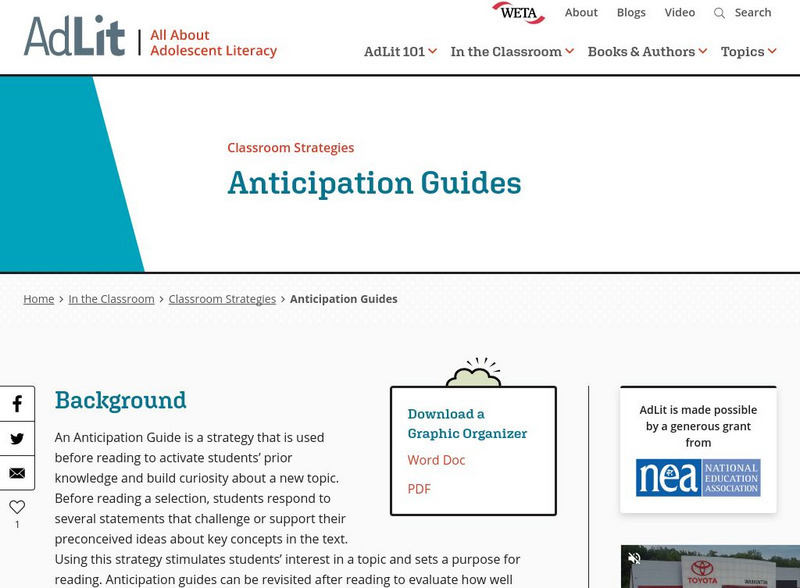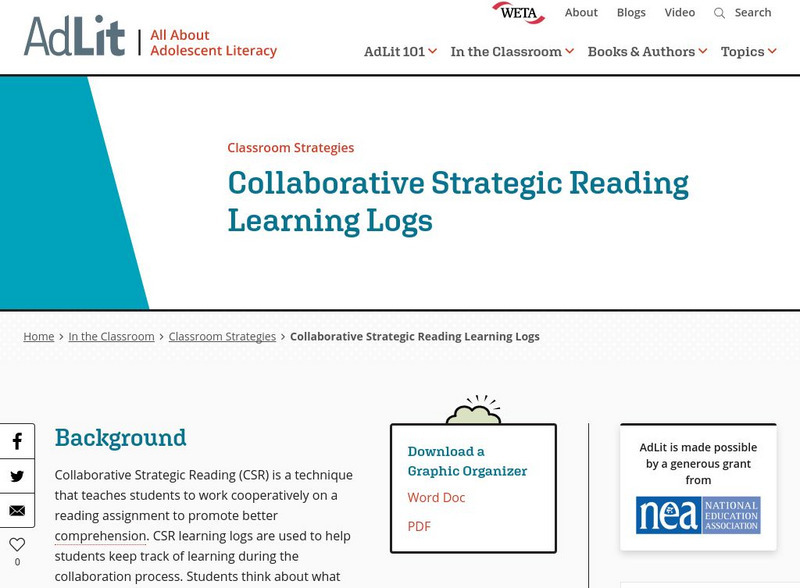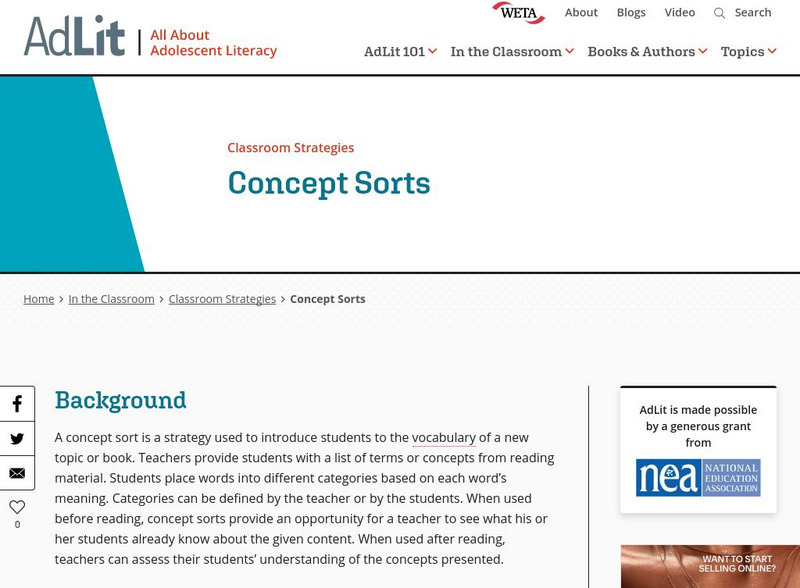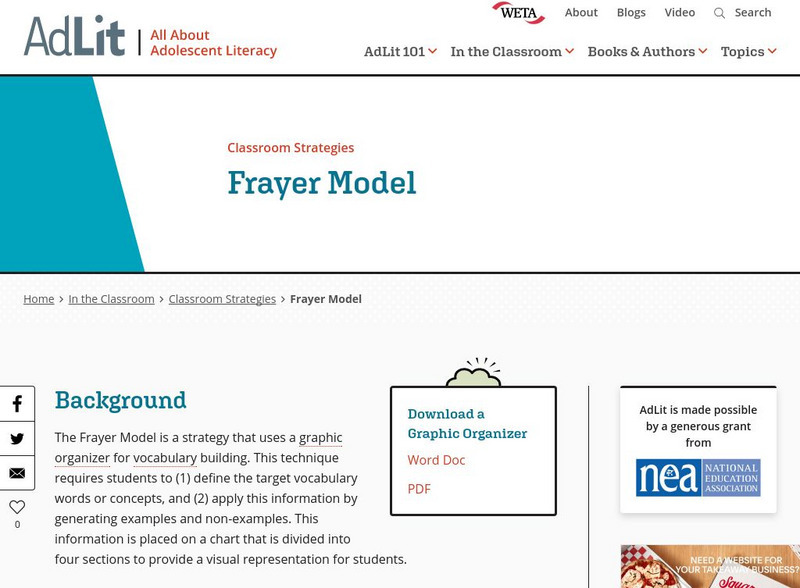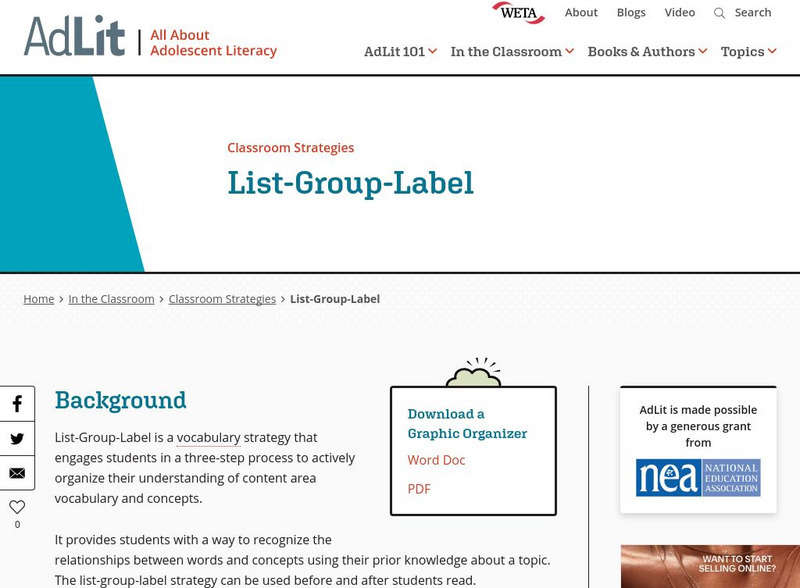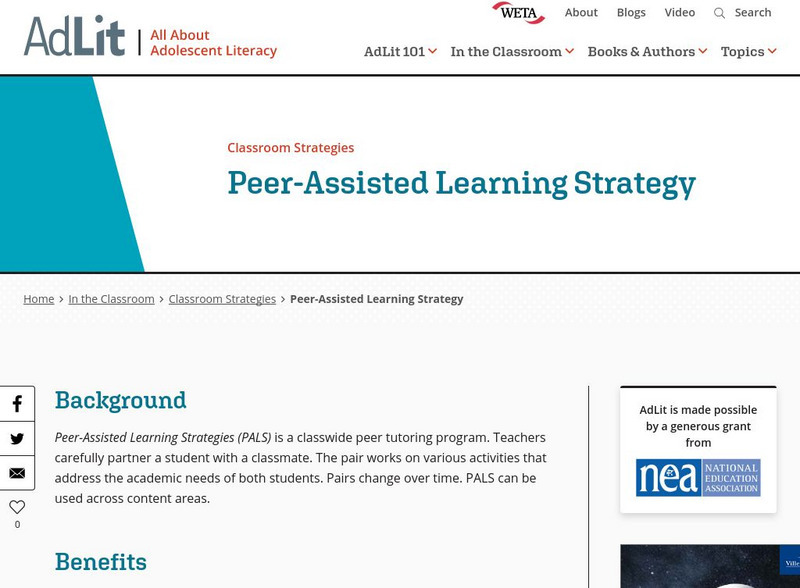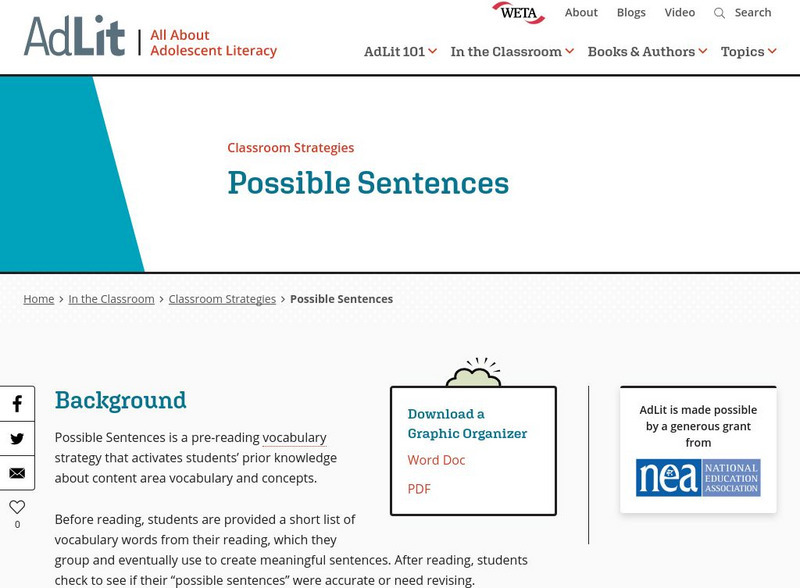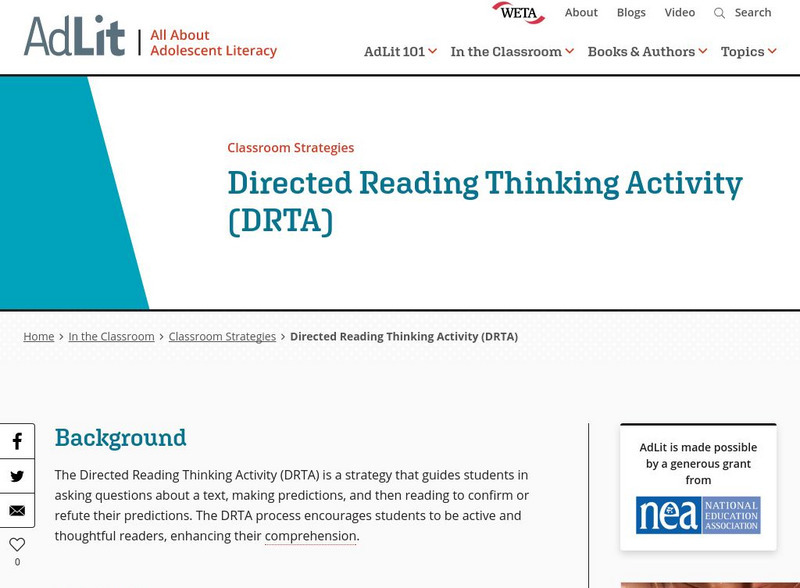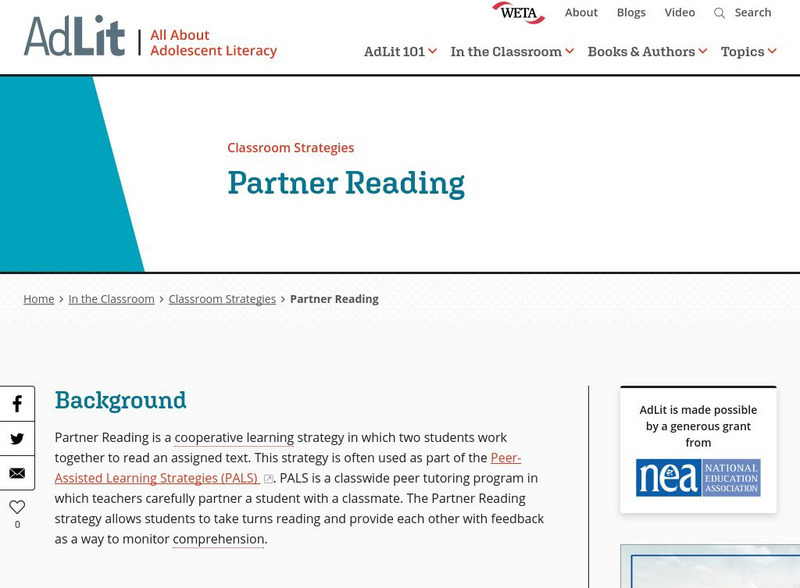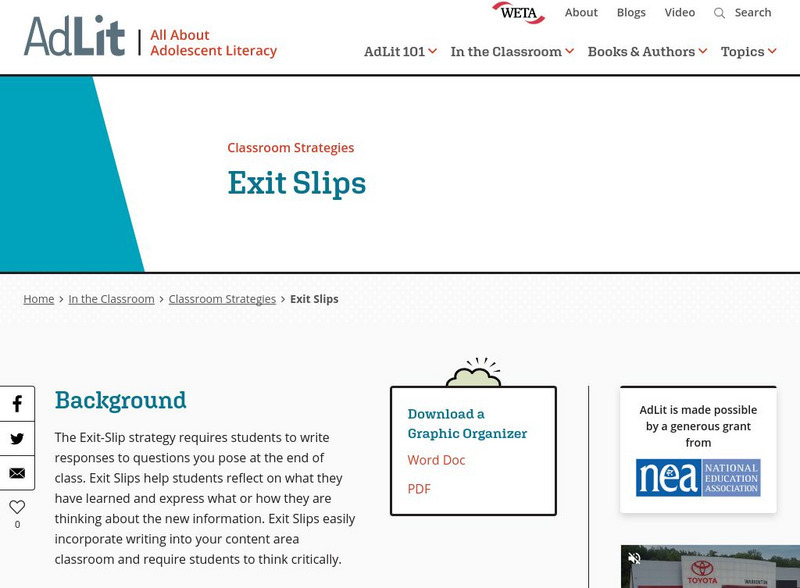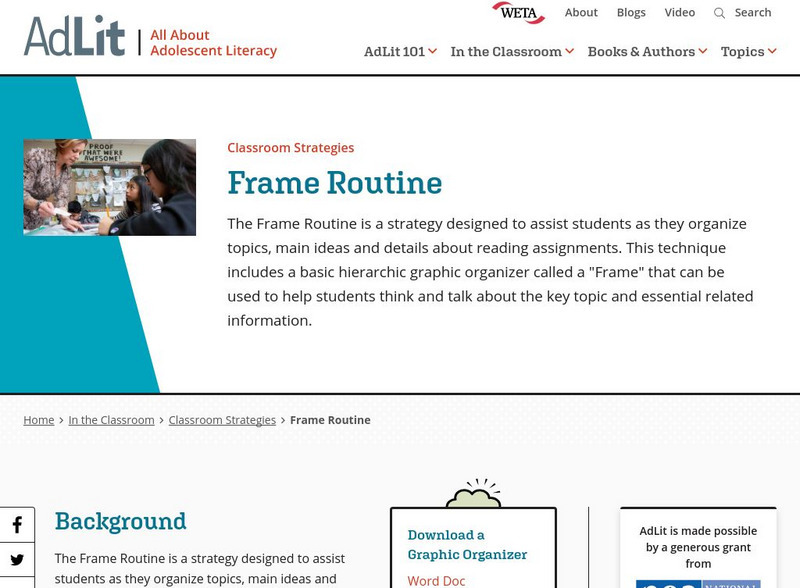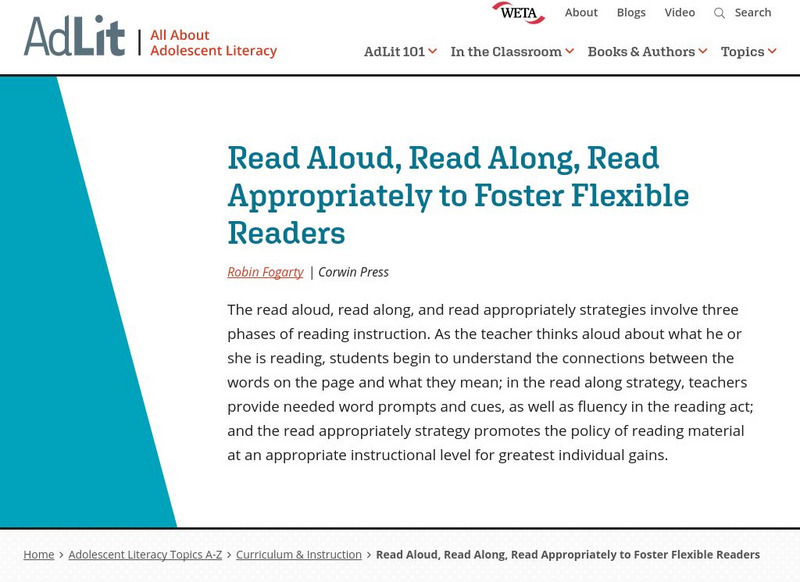AdLit
Ad lit.org: Classroom Strategies: Anticipation Guides
An Anticipation Guide is a strategy that is used before reading to activate students' prior knowledge and build curiosity about a new topic. Before reading a selection, students respond to several statements that challenge or support...
AdLit
Ad lit.org: Classroom Strategies: Collaborative Strategic Reading Learning Logs
Collaborative Strategic Reading (CSR) is a technique that teaches students to work cooperatively on a reading assignment to promote better comprehension. CSR learning logs are used to help students keep track of learning during the...
AdLit
Ad lit.org: Classroom Strategies: Concept Sorts
A concept sort is a strategy used to introduce students to the vocabulary of a new topic or book. Teachers provide students with a list of terms or concepts from reading material. Students place words into different categories based on...
AdLit
Ad lit.org: Classroom Strategies: First Lines
First Lines is a strategy in which students read the beginning sentences from assigned readings and make predictions about the content of what they're about to read. This pre-reading technique helps students focus their attention on what...
AdLit
Ad lit.org: Classroom Strategies: Frayer Model
The Frayer Model is a strategy that uses a graphic organizer for vocabulary building. This technique requires students to (1) define the target vocabulary words or concepts, and (2) apply this information by generating examples and...
AdLit
Ad lit.org: Classroom Strategies: List Group Label
It provides students with a way to recognize the relationships between words and concepts using their prior knowledge about a topic. The list-group-label strategy can be used before and after students read.
AdLit
Ad lit.org: Classroom Strategies: Listen Read Discuss (Lrd)
Listen-Read-Discuss (LRD) (Manzo & Casale, 1985) is a comprehension strategy that builds students' prior knowledge before they read a text. During the first stage, students listen as you present the content of their reading through a...
AdLit
Ad lit.org: Classroom Strategies: Mnemonics
A mnemonic is an instructional strategy designed to help students improve their memory of important information. This technique connects new learning to prior knowledge through the use of visual and/or acoustic cues. The basic types of...
AdLit
Ad lit.org: Classroom Strategies: Peer Assisted Learning Strategy
Peer-Assisted Learning Strategies (PALS) is a classwide peer tutoring program. Teachers carefully partner a student with a classmate. The pair works on various activities that address the academic needs of both students. Pairs change...
AdLit
Ad lit.org: Classroom Strategies: Possible Sentences
Possible Sentences is a pre-reading vocabulary strategy that activates students' prior knowledge about content area vocabulary and concepts.
AdLit
Ad lit.org: Classroom Strategies: Concept Maps
A concept map help students visualize various connections between words or phrases and a main idea. There are several types of concept maps; some are hierarchical, while others connect information without categorizing ideas.
AdLit
Ad lit.org: Classroom Strategies: Directed Reading Thinking Activity (Drta)
The Directed Reading Thinking Activity (DRTA) is a strategy that guides students in asking questions about a text, making predictions, and then reading to confirm or refute their predictions. The DRTA process encourages students to be...
AdLit
Ad lit.org: Classroom Strategies: Inferential Reading
Teaching students to "read influentially" helps them learn how to read more strategically. This technique is derived from the teaching model that learners develop knowledge via the process of interpreting new information in light of past...
AdLit
Ad lit.org: Classroom Strategies: Inquiry Charts (I Charts)
The Inquiry Chart (I-Chart) is a strategy that enables students to generate meaningful questions about a topic and organize their writing. Students integrate prior knowledge or thoughts about the topic with additional information found...
AdLit
Ad lit.org: Classroom Strategies: Jigsaw
Jigsaw is a strategy that emphasizes cooperative learning by providing students an opportunity to actively help each other build comprehension. Use this technique to assign students to reading groups composed of varying skill levels....
AdLit
Ad lit.org: Classroom Strategies: Partner Reading
Partner Reading is a cooperative learning strategy in which two students work together to read an assigned text. This strategy is often used as part of the Peer-Assisted Learning Strategies (PALS). PALS is a classwide peer tutoring...
AdLit
Ad lit.org: Classroom Strategies: Power Notes
Power Notes is a strategy that teaches students an efficient form of organizing information from assigned text. This technique provides students a systematic way to look for relationships within material they are reading. Power Notes...
AdLit
Ad lit.org: Classroom Strategies: Exit Slips
The Exit-Slip strategy requires students to write responses to questions you pose at the end of class. Exit Slips help students reflect on what they have learned and express what or how they are thinking about the new information. Exit...
AdLit
Ad lit.org: Classroom Strategies: Frame Routine
The Frame Routine is a strategy designed to assist students as they organize topics, main ideas and details about reading assignments. This technique includes a basic hierarchic graphic organizer called a "Frame" that can be used to help...
AdLit
Ad lit.org: Scaffold Mindful Silent Reading
Help students internalize and routinize their reading comprehension monitoring with this sample lesson.
AdLit
Ad lit.org: The Teaching Moves of a Strategic Teacher
Research demonstrates the effectiveness of the 12 strategic teaching moves described in this article. On any given day in any given classroom, the strategic teacher employs all of these moves - whether with the whole class, a small...
AdLit
Ad lit.org: Reading (And Scaffolding) Expository Texts
To help students comprehend expository text structures, teachers can acquaint them with the signal or cue words authors utilize in writing each of the structures and use the graphic organizers offered in this article
AdLit
Ad lit.org: Read Aloud, Read Along, Read Appropriately to Foster Flexible Readers
The read aloud, read along, and read appropriately strategies involve three phases of reading instruction. As the teacher thinks aloud about what he or she is reading, students begin to understand the connections between the words on the...
AdLit
Ad lit.org: Effective Reading Programs Grades 6 12: A Best Evidence Synthesis
Many reading programs claim to boost student performance, but how is that measured? Johns Hopkins University examined more than 200 published studies to create this quick guide to programs.


